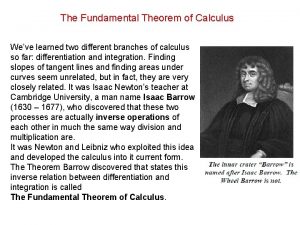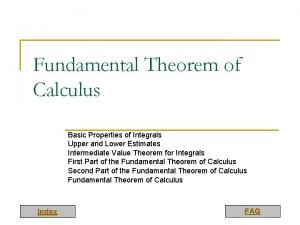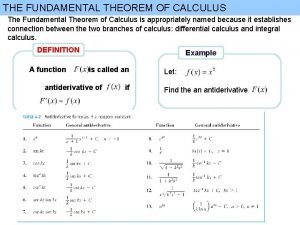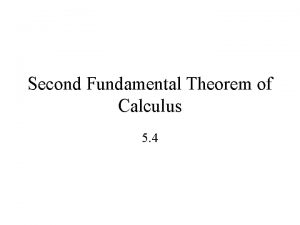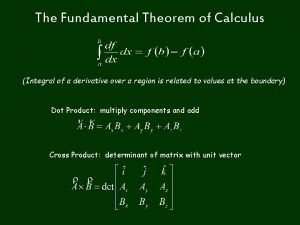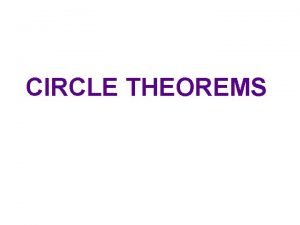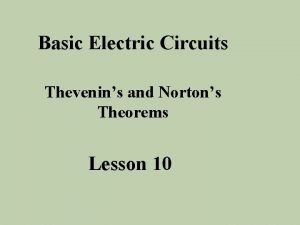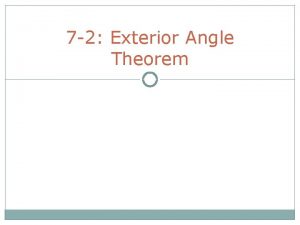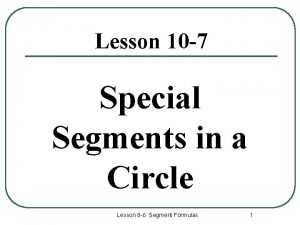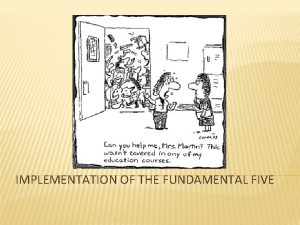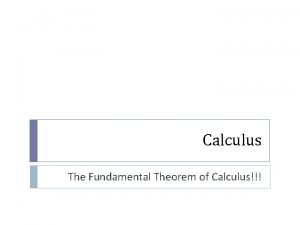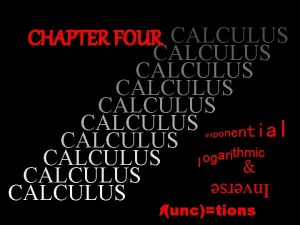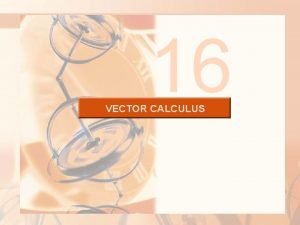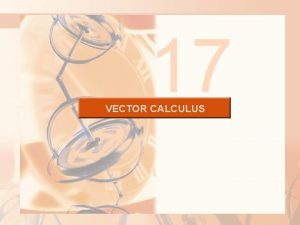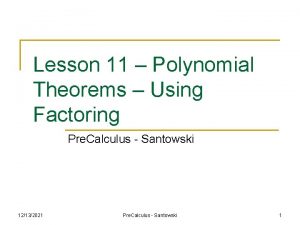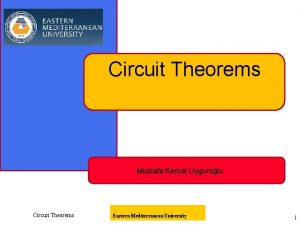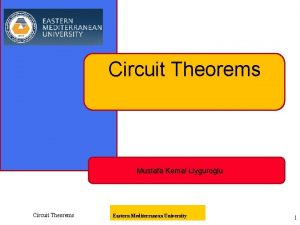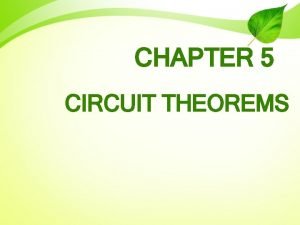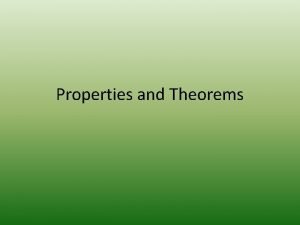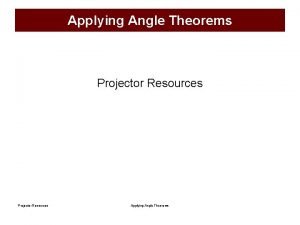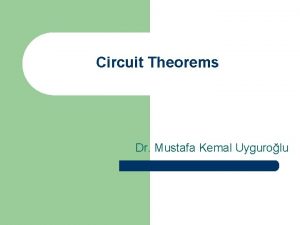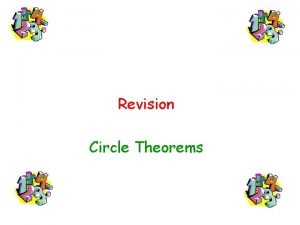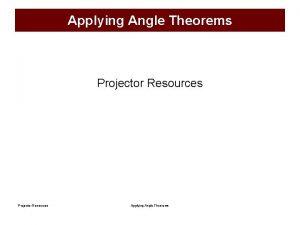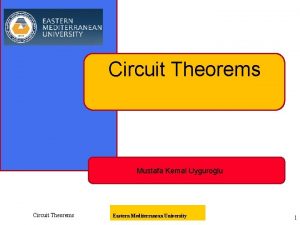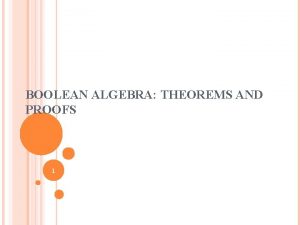The Fundamental Theorems of Calculus Lesson 5 4
























- Slides: 24

The Fundamental Theorems of Calculus Lesson 5. 4

2

3

Don't let this happen to you! 4

Average Value Theorem • Consider function f(x) on an interval a • Area = c b • Consider the existence of a value for x = c such that a < x < b and

Average Value of Function • Also The average value is a c b

Area Under a Curve f(x) a b • We know the area under the curve on the interval [a, b] is given by the formula above • Consider the existence of an Area Function

Area Under a Curve f(x) A(x) a x b • The area function is A(x) … the area under the curve on the interval [a, x] § a≤x≤b • What is A(a)? • What is A(b)? 0

The Area Function f(x) A(x+h) a x x+h b h • If the area is increased by h units § New area is A(x + h) • Area of the new slice is A(x + h) – A(x) § It's height is some average value ŷ § It's width is h

The Area Function • The area of the slice is Divide both sides by h • Now divide by h … then take the limit Why?

The Area Function • The left side of our equation is the derivative of A(x) !! • The derivative of the Area function, A' is the same as the original function, f

Fundamental Theorem of Calculus • We know the antiderivative of f(x) is F(x) + C § Thus A(x) = F(x) + C • Since A(a) = 0 § Then for x = a, 0 = F(a) + C or C = -F(a) § And A(x) = F(x) – F(a) • Now if x = b § A(b) = F(b) – F(a)

Fundamental Theorem of Calculus • We have said that • Thus we conclude § The area under the curve is equal to the difference of the two antiderivatives § Often written

First Fundamental Theorem of Calculus • Given f is § continuous on interval [a, b] § F is any function that satisfies F’(x) = f(x) • Then

First Fundamental Theorem of Calculus • The definite integral can be computed by § finding an antiderivative F on interval [a, b] § evaluating at limits a and b and subtracting • Try

Area Under a Curve • Consider • Area =

Area Under a Curve • Find the area under the following function on the interval [1, 4]

Second Fundamental Theorem of Calculus • Often useful to think of the following form • We can consider this to be a function in terms of x View Movie on next slide

Second Fundamental Theorem of Calculus • This is a function View Demo

Second Fundamental Theorem of Calculus • Suppose we are given G(x) • What is G’(x)?

Second Fundamental Theorem of Calculus • Note that Since this is a constant … • Then • What about ?

Second Fundamental Theorem of Calculus • Try this

Second Fundamental Theorem of Calculus • An application from Differential Equations • Consider • Now integrate both sides • And

Assignment • Lesson 5. 4 • Page 327 • Exercises 1 – 49 odd
 Second fundamental theorem of calculus
Second fundamental theorem of calculus Second fundamental theorem
Second fundamental theorem Fundamental theorem
Fundamental theorem Second fundamental theorem
Second fundamental theorem Fundamental theorem of vector calculus
Fundamental theorem of vector calculus Circle theorems list
Circle theorems list Lesson 3: thevenin's and norton's theorems
Lesson 3: thevenin's and norton's theorems Triangle angle theorems assignment
Triangle angle theorems assignment 10-7 special segments in a circle brewton
10-7 special segments in a circle brewton Power zone fundamental five
Power zone fundamental five Hình ảnh bộ gõ cơ thể búng tay
Hình ảnh bộ gõ cơ thể búng tay Frameset trong html5
Frameset trong html5 Bổ thể
Bổ thể Tỉ lệ cơ thể trẻ em
Tỉ lệ cơ thể trẻ em Gấu đi như thế nào
Gấu đi như thế nào Glasgow thang điểm
Glasgow thang điểm Chúa sống lại
Chúa sống lại Môn thể thao bắt đầu bằng từ đua
Môn thể thao bắt đầu bằng từ đua Thế nào là hệ số cao nhất
Thế nào là hệ số cao nhất Các châu lục và đại dương trên thế giới
Các châu lục và đại dương trên thế giới Công của trọng lực
Công của trọng lực Trời xanh đây là của chúng ta thể thơ
Trời xanh đây là của chúng ta thể thơ Mật thư anh em như thể tay chân
Mật thư anh em như thể tay chân Làm thế nào để 102-1=99
Làm thế nào để 102-1=99 độ dài liên kết
độ dài liên kết
